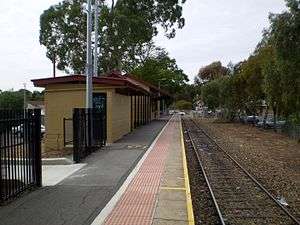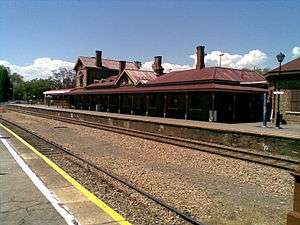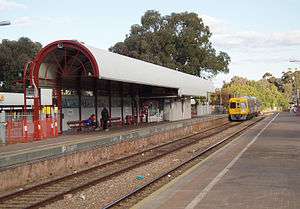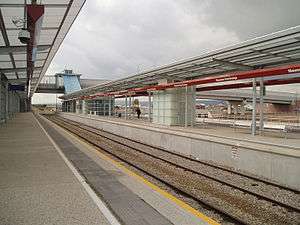Gawler railway line
| Gawler railway line | ||||||||||||||||||||||||||||||||||||||||||||||||||||||||||||||||||||||||||||||||||||||||||||||||||||||||||||||||||||||||||||||||||||||||||||||||||||||||||||||||||||||||||||||||||||||||||||||||||||||||||||||||||||||||||||||||||||||||||||||||||||||||||||||||||||||||||||||||||||||||||||||||||||||||||||||||||||||||||||||||||||||||||||||||||||||||||||||||||||||||||||||||||||||||||||||||||||||||||||||||||||||||||||||||||||||||||||||||||||||||||||||||||||||||||||||||||||||||||||||||||||||||||||||||||||||||||||||||||||||||||||||||||||||||||||||||||||||||||||||
|---|---|---|---|---|---|---|---|---|---|---|---|---|---|---|---|---|---|---|---|---|---|---|---|---|---|---|---|---|---|---|---|---|---|---|---|---|---|---|---|---|---|---|---|---|---|---|---|---|---|---|---|---|---|---|---|---|---|---|---|---|---|---|---|---|---|---|---|---|---|---|---|---|---|---|---|---|---|---|---|---|---|---|---|---|---|---|---|---|---|---|---|---|---|---|---|---|---|---|---|---|---|---|---|---|---|---|---|---|---|---|---|---|---|---|---|---|---|---|---|---|---|---|---|---|---|---|---|---|---|---|---|---|---|---|---|---|---|---|---|---|---|---|---|---|---|---|---|---|---|---|---|---|---|---|---|---|---|---|---|---|---|---|---|---|---|---|---|---|---|---|---|---|---|---|---|---|---|---|---|---|---|---|---|---|---|---|---|---|---|---|---|---|---|---|---|---|---|---|---|---|---|---|---|---|---|---|---|---|---|---|---|---|---|---|---|---|---|---|---|---|---|---|---|---|---|---|---|---|---|---|---|---|---|---|---|---|---|---|---|---|---|---|---|---|---|---|---|---|---|---|---|---|---|---|---|---|---|---|---|---|---|---|---|---|---|---|---|---|---|---|---|---|---|---|---|---|---|---|---|---|---|---|---|---|---|---|---|---|---|---|---|---|---|---|---|---|---|---|---|---|---|---|---|---|---|---|---|---|---|---|---|---|---|---|---|---|---|---|---|---|---|---|---|---|---|---|---|---|---|---|---|---|---|---|---|---|---|---|---|---|---|---|---|---|---|---|---|---|---|---|---|---|---|---|---|---|---|---|---|---|---|---|---|---|---|---|---|---|---|---|---|---|---|---|---|---|---|---|---|---|---|---|---|---|---|---|---|---|---|---|---|---|---|---|---|---|---|---|---|---|---|---|---|---|---|---|---|---|---|---|---|---|---|---|---|---|---|---|---|---|---|---|---|---|---|---|---|---|---|---|---|---|---|---|---|---|---|---|---|---|---|---|---|---|---|---|---|---|---|---|---|---|---|---|---|---|---|---|---|---|---|---|---|---|---|---|---|---|---|---|---|---|---|---|---|---|---|---|---|---|---|---|---|---|---|---|---|---|---|---|---|---|---|---|---|---|---|---|---|---|---|---|---|---|---|---|---|---|---|---|---|---|---|---|---|---|---|---|---|---|---|---|---|---|---|---|---|---|---|---|---|---|---|---|---|---|---|---|---|---|---|---|---|---|---|---|---|---|---|---|---|---|---|---|---|---|---|---|
 | ||||||||||||||||||||||||||||||||||||||||||||||||||||||||||||||||||||||||||||||||||||||||||||||||||||||||||||||||||||||||||||||||||||||||||||||||||||||||||||||||||||||||||||||||||||||||||||||||||||||||||||||||||||||||||||||||||||||||||||||||||||||||||||||||||||||||||||||||||||||||||||||||||||||||||||||||||||||||||||||||||||||||||||||||||||||||||||||||||||||||||||||||||||||||||||||||||||||||||||||||||||||||||||||||||||||||||||||||||||||||||||||||||||||||||||||||||||||||||||||||||||||||||||||||||||||||||||||||||||||||||||||||||||||||||||||||||||||||||||||
| Overview | ||||||||||||||||||||||||||||||||||||||||||||||||||||||||||||||||||||||||||||||||||||||||||||||||||||||||||||||||||||||||||||||||||||||||||||||||||||||||||||||||||||||||||||||||||||||||||||||||||||||||||||||||||||||||||||||||||||||||||||||||||||||||||||||||||||||||||||||||||||||||||||||||||||||||||||||||||||||||||||||||||||||||||||||||||||||||||||||||||||||||||||||||||||||||||||||||||||||||||||||||||||||||||||||||||||||||||||||||||||||||||||||||||||||||||||||||||||||||||||||||||||||||||||||||||||||||||||||||||||||||||||||||||||||||||||||||||||||||||||||
| Locale | Adelaide, South Australia | |||||||||||||||||||||||||||||||||||||||||||||||||||||||||||||||||||||||||||||||||||||||||||||||||||||||||||||||||||||||||||||||||||||||||||||||||||||||||||||||||||||||||||||||||||||||||||||||||||||||||||||||||||||||||||||||||||||||||||||||||||||||||||||||||||||||||||||||||||||||||||||||||||||||||||||||||||||||||||||||||||||||||||||||||||||||||||||||||||||||||||||||||||||||||||||||||||||||||||||||||||||||||||||||||||||||||||||||||||||||||||||||||||||||||||||||||||||||||||||||||||||||||||||||||||||||||||||||||||||||||||||||||||||||||||||||||||||||||||||
| Termini |
Adelaide Gawler Central | |||||||||||||||||||||||||||||||||||||||||||||||||||||||||||||||||||||||||||||||||||||||||||||||||||||||||||||||||||||||||||||||||||||||||||||||||||||||||||||||||||||||||||||||||||||||||||||||||||||||||||||||||||||||||||||||||||||||||||||||||||||||||||||||||||||||||||||||||||||||||||||||||||||||||||||||||||||||||||||||||||||||||||||||||||||||||||||||||||||||||||||||||||||||||||||||||||||||||||||||||||||||||||||||||||||||||||||||||||||||||||||||||||||||||||||||||||||||||||||||||||||||||||||||||||||||||||||||||||||||||||||||||||||||||||||||||||||||||||||
| Stations | ||||||||||||||||||||||||||||||||||||||||||||||||||||||||||||||||||||||||||||||||||||||||||||||||||||||||||||||||||||||||||||||||||||||||||||||||||||||||||||||||||||||||||||||||||||||||||||||||||||||||||||||||||||||||||||||||||||||||||||||||||||||||||||||||||||||||||||||||||||||||||||||||||||||||||||||||||||||||||||||||||||||||||||||||||||||||||||||||||||||||||||||||||||||||||||||||||||||||||||||||||||||||||||||||||||||||||||||||||||||||||||||||||||||||||||||||||||||||||||||||||||||||||||||||||||||||||||||||||||||||||||||||||||||||||||||||||||||||||||||
| Services |
| |||||||||||||||||||||||||||||||||||||||||||||||||||||||||||||||||||||||||||||||||||||||||||||||||||||||||||||||||||||||||||||||||||||||||||||||||||||||||||||||||||||||||||||||||||||||||||||||||||||||||||||||||||||||||||||||||||||||||||||||||||||||||||||||||||||||||||||||||||||||||||||||||||||||||||||||||||||||||||||||||||||||||||||||||||||||||||||||||||||||||||||||||||||||||||||||||||||||||||||||||||||||||||||||||||||||||||||||||||||||||||||||||||||||||||||||||||||||||||||||||||||||||||||||||||||||||||||||||||||||||||||||||||||||||||||||||||||||||||||
| Operation | ||||||||||||||||||||||||||||||||||||||||||||||||||||||||||||||||||||||||||||||||||||||||||||||||||||||||||||||||||||||||||||||||||||||||||||||||||||||||||||||||||||||||||||||||||||||||||||||||||||||||||||||||||||||||||||||||||||||||||||||||||||||||||||||||||||||||||||||||||||||||||||||||||||||||||||||||||||||||||||||||||||||||||||||||||||||||||||||||||||||||||||||||||||||||||||||||||||||||||||||||||||||||||||||||||||||||||||||||||||||||||||||||||||||||||||||||||||||||||||||||||||||||||||||||||||||||||||||||||||||||||||||||||||||||||||||||||||||||||||||
| Opened | 1857 | |||||||||||||||||||||||||||||||||||||||||||||||||||||||||||||||||||||||||||||||||||||||||||||||||||||||||||||||||||||||||||||||||||||||||||||||||||||||||||||||||||||||||||||||||||||||||||||||||||||||||||||||||||||||||||||||||||||||||||||||||||||||||||||||||||||||||||||||||||||||||||||||||||||||||||||||||||||||||||||||||||||||||||||||||||||||||||||||||||||||||||||||||||||||||||||||||||||||||||||||||||||||||||||||||||||||||||||||||||||||||||||||||||||||||||||||||||||||||||||||||||||||||||||||||||||||||||||||||||||||||||||||||||||||||||||||||||||||||||||
| Rolling stock | ||||||||||||||||||||||||||||||||||||||||||||||||||||||||||||||||||||||||||||||||||||||||||||||||||||||||||||||||||||||||||||||||||||||||||||||||||||||||||||||||||||||||||||||||||||||||||||||||||||||||||||||||||||||||||||||||||||||||||||||||||||||||||||||||||||||||||||||||||||||||||||||||||||||||||||||||||||||||||||||||||||||||||||||||||||||||||||||||||||||||||||||||||||||||||||||||||||||||||||||||||||||||||||||||||||||||||||||||||||||||||||||||||||||||||||||||||||||||||||||||||||||||||||||||||||||||||||||||||||||||||||||||||||||||||||||||||||||||||||||
| Events | ||||||||||||||||||||||||||||||||||||||||||||||||||||||||||||||||||||||||||||||||||||||||||||||||||||||||||||||||||||||||||||||||||||||||||||||||||||||||||||||||||||||||||||||||||||||||||||||||||||||||||||||||||||||||||||||||||||||||||||||||||||||||||||||||||||||||||||||||||||||||||||||||||||||||||||||||||||||||||||||||||||||||||||||||||||||||||||||||||||||||||||||||||||||||||||||||||||||||||||||||||||||||||||||||||||||||||||||||||||||||||||||||||||||||||||||||||||||||||||||||||||||||||||||||||||||||||||||||||||||||||||||||||||||||||||||||||||||||||||||
| Re-sleepered (concrete) | 2010-12 | |||||||||||||||||||||||||||||||||||||||||||||||||||||||||||||||||||||||||||||||||||||||||||||||||||||||||||||||||||||||||||||||||||||||||||||||||||||||||||||||||||||||||||||||||||||||||||||||||||||||||||||||||||||||||||||||||||||||||||||||||||||||||||||||||||||||||||||||||||||||||||||||||||||||||||||||||||||||||||||||||||||||||||||||||||||||||||||||||||||||||||||||||||||||||||||||||||||||||||||||||||||||||||||||||||||||||||||||||||||||||||||||||||||||||||||||||||||||||||||||||||||||||||||||||||||||||||||||||||||||||||||||||||||||||||||||||||||||||||||
| Electrified | Work to commence in 2018 | |||||||||||||||||||||||||||||||||||||||||||||||||||||||||||||||||||||||||||||||||||||||||||||||||||||||||||||||||||||||||||||||||||||||||||||||||||||||||||||||||||||||||||||||||||||||||||||||||||||||||||||||||||||||||||||||||||||||||||||||||||||||||||||||||||||||||||||||||||||||||||||||||||||||||||||||||||||||||||||||||||||||||||||||||||||||||||||||||||||||||||||||||||||||||||||||||||||||||||||||||||||||||||||||||||||||||||||||||||||||||||||||||||||||||||||||||||||||||||||||||||||||||||||||||||||||||||||||||||||||||||||||||||||||||||||||||||||||||||||
| Technical | ||||||||||||||||||||||||||||||||||||||||||||||||||||||||||||||||||||||||||||||||||||||||||||||||||||||||||||||||||||||||||||||||||||||||||||||||||||||||||||||||||||||||||||||||||||||||||||||||||||||||||||||||||||||||||||||||||||||||||||||||||||||||||||||||||||||||||||||||||||||||||||||||||||||||||||||||||||||||||||||||||||||||||||||||||||||||||||||||||||||||||||||||||||||||||||||||||||||||||||||||||||||||||||||||||||||||||||||||||||||||||||||||||||||||||||||||||||||||||||||||||||||||||||||||||||||||||||||||||||||||||||||||||||||||||||||||||||||||||||||
| Line length | 42.2 km (26.2 mi) | |||||||||||||||||||||||||||||||||||||||||||||||||||||||||||||||||||||||||||||||||||||||||||||||||||||||||||||||||||||||||||||||||||||||||||||||||||||||||||||||||||||||||||||||||||||||||||||||||||||||||||||||||||||||||||||||||||||||||||||||||||||||||||||||||||||||||||||||||||||||||||||||||||||||||||||||||||||||||||||||||||||||||||||||||||||||||||||||||||||||||||||||||||||||||||||||||||||||||||||||||||||||||||||||||||||||||||||||||||||||||||||||||||||||||||||||||||||||||||||||||||||||||||||||||||||||||||||||||||||||||||||||||||||||||||||||||||||||||||||
| Number of tracks |
Double track to Gawler Single track to Gawler Central | |||||||||||||||||||||||||||||||||||||||||||||||||||||||||||||||||||||||||||||||||||||||||||||||||||||||||||||||||||||||||||||||||||||||||||||||||||||||||||||||||||||||||||||||||||||||||||||||||||||||||||||||||||||||||||||||||||||||||||||||||||||||||||||||||||||||||||||||||||||||||||||||||||||||||||||||||||||||||||||||||||||||||||||||||||||||||||||||||||||||||||||||||||||||||||||||||||||||||||||||||||||||||||||||||||||||||||||||||||||||||||||||||||||||||||||||||||||||||||||||||||||||||||||||||||||||||||||||||||||||||||||||||||||||||||||||||||||||||||||
| Track gauge | 1,600 mm (5 ft 3 in) | |||||||||||||||||||||||||||||||||||||||||||||||||||||||||||||||||||||||||||||||||||||||||||||||||||||||||||||||||||||||||||||||||||||||||||||||||||||||||||||||||||||||||||||||||||||||||||||||||||||||||||||||||||||||||||||||||||||||||||||||||||||||||||||||||||||||||||||||||||||||||||||||||||||||||||||||||||||||||||||||||||||||||||||||||||||||||||||||||||||||||||||||||||||||||||||||||||||||||||||||||||||||||||||||||||||||||||||||||||||||||||||||||||||||||||||||||||||||||||||||||||||||||||||||||||||||||||||||||||||||||||||||||||||||||||||||||||||||||||||
| ||||||||||||||||||||||||||||||||||||||||||||||||||||||||||||||||||||||||||||||||||||||||||||||||||||||||||||||||||||||||||||||||||||||||||||||||||||||||||||||||||||||||||||||||||||||||||||||||||||||||||||||||||||||||||||||||||||||||||||||||||||||||||||||||||||||||||||||||||||||||||||||||||||||||||||||||||||||||||||||||||||||||||||||||||||||||||||||||||||||||||||||||||||||||||||||||||||||||||||||||||||||||||||||||||||||||||||||||||||||||||||||||||||||||||||||||||||||||||||||||||||||||||||||||||||||||||||||||||||||||||||||||||||||||||||||||||||||||||||||
The Gawler railway line (also known as the Gawler Central railway line) is a suburban commuter railway line in the city of Adelaide, South Australia. It is the only rail route in Adelaide to have no interchange with another line at any station except Adelaide.
History
The line was opened in 1857 from Adelaide to Gawler,[1][2] and extended to Kapunda in 1860. Branches would later be built out from Gawler to termini in Angaston, Truro, Morgan, Robertstown, Peterborough, Spalding and Gladstone.
South of Gawler, there were branches into the Holden Australia factory at Elizabeth South, the Penfield railway line which serviced the former munitions factory and other Defence facilities, and the Port Pirie line also branched from the Gawler line at Salisbury railway station until it was converted to standard gauge with a new track laid alongside the broad gauge tracks.
At Dry Creek, the Dry Creek-Port Adelaide railway line branches west, and the Northfield railway line used to branch east.
Today the line is only served by Adelaide Metro services using 3000 class railcars operating from Adelaide station to Gawler Central station.[3] The 2000 class railcars were retired in August 2015.[4]
The last freight service on the line was the Penrice Stone Train which operated to Penrice until it ceased operating in June 2014.[5]
Between Adelaide and Salisbury, the two broad gauge lines are paralleled by one standard gauge line on the Adelaide to Port Augusta line, from Salisbury to Gawler there are two tracks, with a single track north of Gawler.
In 2008, the State Government announced a plan to rebuild the Gawler line in preparation for the line to be electrified with the Federal Government also to provide funding.[6]
This work saw the track removed, with the track bed and track renewed. Dual gauge sleepers were laid to allow for the line to be converted to standard gauge at a future date. The line was closed between North Adelaide and Mawson Interchange for four months from June 2010 for this work to be performed, and Mawson Interchange and Gawler Central station for seven months from September 2011.[7][8][9]
Following the withdrawal of the Federal Government funding, the electrification was postponed in October 2013.[10] In June 2014, it was announced that the electrification of the line as far as Salisbury will commence in 2018.[11]
In 2017, the Gawler line between Adelaide and Mawson Lakes was closed along with the Outer Harbor and Grange lines during April, June, and July to work on the Torrens Rail Junction Project in Bowden.[12][13][14]; younger patrons were not pleased with the July closing because it coincidences with AVCon.
Route
The line runs from Adelaide station north via the major suburbs of Mawson Lakes, Salisbury, Elizabeth and Smithfield to the town Gawler on the outer northern metropolitan fringe. The line is 42.2 kilometres in length and is currently the longest of the Adelaide suburban railway lines.
Like the rest of the Adelaide suburban passenger rail network, the line is 1,600 mm (5 ft 3 in) broad gauge for its entire length. The Australian Rail Track Corporation's standard gauge Adelaide to Port Augusta line runs parallel to the route from the Gaol Triangle as far as Salisbury, then turns north west towards Virginia.
Services
All suburban passenger services are operated by Adelaide Metro. On 28 April 2008, new timetables were introduced on the Gawler line in an effort to boost efficiency on the line. Shorter secondary services that terminated at Dry Creek and Salisbury were withdrawn, new limited express services introduced, and a new Hi-Frequency station policy adopted.[3]
Under this policy, Hi-Frequency stations have services every 15 minutes during off-peak and peak times, while all other stations receive 30 minute intervals during both periods. This is in addition to several peak hour express services that stop at only major stations such as Mawson Interchange, Salisbury, Elizabeth, Smithfield and Gawler.[3]
Weekend services operate with 30 minute frequency, and every second train runs express between Adelaide and Dry Creek using 3000 class railcars. Evening/Night services are hourly and stop at all station with the exception of North Adelaide.[3] Until April 2008, most services along the line were operated by 3000 class railcars. However with the introduction of the new timetable, 2000 class railcars became more frequent especially during peak hour.
Nearly all services either start or terminate their journey at Gawler or Gawler Central stations apart from a morning peak express service that commences its journey at Salisbury.[3]
Freight
Freight is still a major factor along this transport corridor, with the Australian Rail Track Corporation's Adelaide to Port Augusta line running parallel to Salisbury. Since 1984, this line has been standard gauge and had no interface with the suburban lines. Aurizon, Genesee & Wyoming Australia, Pacific National, SCT Logistics, and Great Southern Rail operate services via the line, with the latter operating The Ghan and Indian Pacific passenger trains along this section.
Until 2007, grain trains operated from Roseworthy to Port Adelaide. The last freight service on the Gawler line was the Penrice Stone Train which operated to Penrice until it ceased operating in June 2014.[5]
Railcar depot relocation
On 6 February 2011, a new Adelaide Metro railcar depot opened to the east of Dry Creek station to replace the facility outside of Adelaide station.[15] The depot is the major maintenance and re-fuelling facility for the 2000 and 3000 class diesel fleets, with capacity to store 70 railcars with over 11 kilometres of track. The depot has been designed to allow future conversion to support electric rollingstock.
Gallery
 Gawler station, one of two terminus stations in the town of Gawler
Gawler station, one of two terminus stations in the town of Gawler Elizabeth Interchange before its upgrade in 2011/12
Elizabeth Interchange before its upgrade in 2011/12 Salisbury Interchange, one of the 3 busiest stations on the entire network
Salisbury Interchange, one of the 3 busiest stations on the entire network Mawson Interchange station, opened in early 2006
Mawson Interchange station, opened in early 2006
References
- ↑ Bassett Town & the Railway Town of Gawler
- ↑ "Place ID 6072". Australian Heritage Database. Department of the Environment.
- 1 2 3 4 5 Gawler timetable Archived 10 February 2014 at the Wayback Machine. Adelaide Metro 4 February 2013
- ↑ "Limited life for 2000 class Jumbo railcars" Railway Digest January 2015 page 20
- 1 2 Penrice soda ash plant at Osborne closing ABC News 25 June 2014
- ↑ 2008/09 State Budget South Australian Department of Treasury & Finance June 2008
- ↑ Gawler Line Reconstruction Coleman Rail
- ↑ Gawler Line timetable Adelaide Metro
- ↑ Rail Revitalisation Gawler Line Department for Transport, Energy & Infrastructure
- ↑ Federal Government pulls plug on $76m Gawler Line electrification Adelaide Advertiser 24 October 2013
- ↑ Rail Revitalisation Gawler Line Department of Planning, Transport & Infrastructure
- ↑ Outer Harbor, Grange and Gawler rail line closures
- ↑ Outer Harbor, Grange and Gawler train lines temporary closures June long weekend
- ↑ Outer Harbor, Grange and Gawler line July closure
- ↑ Railcar Depot Relocation Archived 13 April 2014 at the Wayback Machine. Department of Planning, Transport & Infrastructure
External links
- Gallery of track refurbishment work: Adelaide to Mawson Interchange Johnny's Pages
- Gallery of track refurbishment work: Mawson Lakes to Gawler Johnny's Pages
- Gallery of track refurbishment work: Mawson Lakes to Gawler Johnny's Pages
- Gallery of track refurbishment work: Gawler to Gawler Central Johnny's Pages
- Gallery of electrification work: Adelaide to Gawler Johnny's Pages